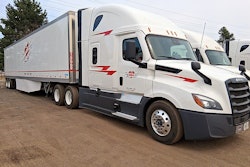Spot loads increased for the week of April 20 through 26, according to DAT, as importers move inventory ahead of tariff uncertainty.
Importers and domestic companies are moving goods to avoid early possible tariffs, even if their products haven’t been targeted yet, said DAT Freight & Analytics industry analyst Dean Croke.
“We’re seeing a lot of just-in-case loads moving on new lanes as shippers find new locations to store inventory being stockpiled, and new lanes emerging as shippers source goods from new suppliers,” said Croke, adding that this has led to new shipping routes and more loads being posted on the spot market.
The number of loads posted to the DAT One network increased by 10.8% week-over-week to 2.25 million, signaling strong seasonal demand especially from retail and produce sectors.
Croke said they expect elevated freight activity to last through July 4 or until the current 90-day pause on new tariffs ends.
“Anything to do with Chinese imports, will, of course, see an immediate fall-off in demand starting next week, once the pre-tariff wave of containers clear customs,” he said, with a sharp drop especially hitting West Coast ports like Los Angeles and Long Beach. Drayage carriers and import-related warehouse workers will also feel the impact.
Truck posts dropped sharply at 7.3%, the lowest for Week 17 in at least nine years, and down 45% year-over-year.
According to DAT, dry van loads rose 14.2% week-over-week, while equipment fell 6.8%. Reefer loads jumped 18.5% week-over-week, with equipment down at 9.6%. Flatbed loads increased 5.0% week-over-week, with equipment down at 7.0%. Rates for all three segments went up 1 cent.
Van loads surged 32% in DAT’s Los Angeles market week-over-week, with top destination markets including Stockton, Phoenix, San Francisco, and Salt Lake City.
Flatbed demand is seeing seasonal activity, Croke added, as it’s driven by higher volumes of freight moving to avoid tariffs, especially steel, aluminum and lumber. “This all happened as we reached the spring intersection of building, construction, planting, nursery and machinery import seasons in April. Add tariffs to the mix, and you have a surge in spot market demand in the open deck sector and elevated spot rates as a result,” Croke said.
While reefer load posts are up for the third week in a row, actual produce volumes remain weak, down 23% year-over-year nationally, and 49% lower in California, which Croke said could be due to consumer spending weakening. In terms of volumes, California truckload volumes year-to-date are down 55%, while national produce are down 7% lower than last year.
“Although it’s early in the season, we have a lot of ground to make up if produce season is to deliver volumes that causes dry van and reefer rates to spike on July 4,” Croke said. “We may see more of a speed bump this year if demand remains soft.”
Despite higher volumes, rates are mostly flat because many carriers are still in the market, operating at a lower costs.
Croke explained, “This latent capacity is now choosier about when, where, and for how much they operate. They tend to sit on the sidelines and wait for demand to improve, dive back into the market then head back home again when demand cools. This has the effect of flattening spot rates whenever demand surges.”














